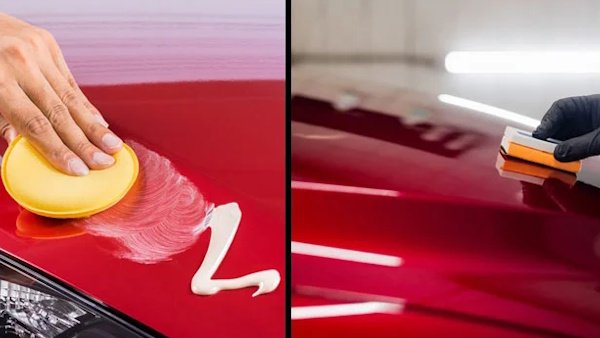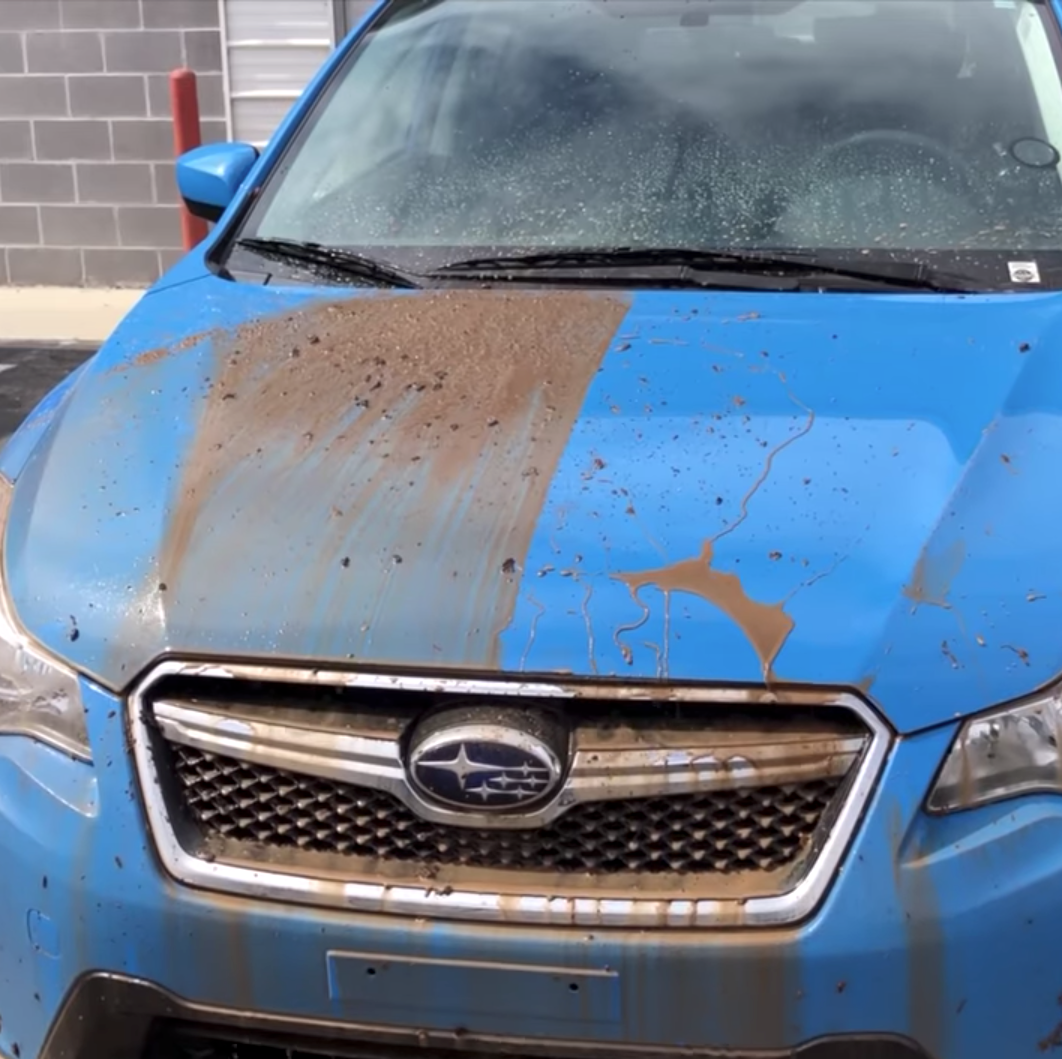Checking out the Scientific Research Behind Car Ceramic Coating and Its Safety Characteristics
The science of car ceramic coating offers a fascinating study in innovative automotive security. Composed mostly of silicon dioxide and polymers, these coatings form a robust bond with vehicle paint. This interaction boosts longevity versus ecological threats while supplying hydrophobic advantages. The details of exactly how these finishings job and their lasting benefits remain much less recognized. Ceramic Coating Newark. Unloading these information discloses why ceramic finishes are becoming a preferred selection for automobile treatment
What Is Ceramic Coating?
Ceramic coating is a fluid polymer that chemically bonds to the surface area of a lorry's paint. This advanced safety layer enhances toughness and supplies premium resistance to ecological aspects. Unlike traditional wax or sealants, which give temporary security, ceramic finishings create a resilient guard that can hold up against harsh conditions such as UV rays, acidic contaminants, and severe climate. When used appropriately, the coating develops a hydrophobic surface, causing water to grain and slide off, which assists in maintaining the lorry's sanitation. In addition, it provides improved gloss and deepness to the paint, making the car show up more refined and vibrant. The application procedure commonly involves thorough surface prep work, consisting of cleaning and polishing, to assure peak bonding. Because of this, ceramic layers are becoming significantly preferred among car fanatics and those seeking to shield their investments, assuring to maintain the lorry's visual allure while reducing the frequency of upkeep.
The Structure of Ceramic Coatings
The elaborate formulation of ceramic finishings primarily is composed of silicon dioxide (SiO2), which is stemmed from all-natural resources like quartz and sand. This vital part provides the foundation for the coating's longevity and protective high qualities. In addition to SiO2, ceramic finishes usually consist of different polymers and ingredients that improve adhesion, flexibility, and resistance to environmental variables. These substances work synergistically to create a durable barrier against impurities such as dirt, chemicals, and UV rays.Furthermore, some solutions include titanium dioxide (TiO2) or other nanomaterials, which can enhance the coating's hydrophobic homes, leading to better water repellency. The specific composition can differ greatly amongst producers, influencing performance and durability. Eventually, the mix of these elements finishes in a protective layer that not only improves the aesthetic appeal of lorries however additionally offers to extend their life-span by shielding the surface area from possible damages.
Just How Ceramic Coatings Work
Recognizing just how ceramic finishes function includes exploring their chemical make-up, which adds to their protective qualities. The application process is necessary for achieving excellent results, while durability and resilience elements figure out the coating's effectiveness with time. With each other, these components highlight the advantages and efficiency of ceramic layers for lorry defense.
Chemical Make-up Explained
While several car owners seek long-lasting defense for their cars, the chemical composition of ceramic layers plays a critical role in their efficiency. These layers mostly consist of silicon dioxide (SiO2), which is acquired from natural minerals. This compound creates a strong bond with the automobile's paint, producing a resilient, safety layer. Furthermore, lots of ceramic coatings include titanium dioxide (TiO2), enhancing their hydrophobic homes and resistance to UV rays. The visibility of polysiloxanes can further boost adaptability and resilience. With each other, these elements add to the coating's capability to push back water, dirt, and pollutants, while likewise supplying a high-gloss coating. Comprehending this chemical structure assists car owners appreciate the robust security supplied by ceramic layers.
Application Refine Review
Applying ceramic coverings involves a meticulous process that assures excellent bonding and defense for the vehicle's surface. Detailed cleaning and decontamination of the car's outside are carried out to get rid of dirt, crud, and previous waxes. This step confirms that the surface area is without pollutants that could hinder bond. Following this, the paint is typically polished to improve clearness and remove any type of flaws. Once prepared, the ceramic coating is applied in small areas using an applicator pad, permitting consistent coverage. The coating is after that delegated treat, creating a strong chemical bond with the surface area. Appropriate treating times and problems are crucial, as they verify the coating attains its optimum effectiveness and protective top qualities.
Long Life and Sturdiness Variables
Ceramic layers are designed to offer durable protection via their sophisticated chemical composition, which produces a robust obstacle versus environmental pollutants. The sturdiness of these layers is affected by aspects such as the thickness of the application, the quality of the product, and the conditions under which the lorry is exposed. Top notch ceramic finishes can last a number of years, resisting scratches, UV rays, and chemical spots. Proper upkeep, consisting of normal washing and regular reapplication, can additionally boost longevity. Furthermore, ecological variables like environment and direct exposure to contaminants can impact the life expectancy of the coating. Click This Link Generally, when applied and maintained correctly, ceramic coatings supply outstanding resilience, making them a preferred choice for car lovers seeking to maintain their car's appearance.
Hydrophobic Qualities and Water Repellency
Hydrophobic residential properties are a trademark of top quality car ceramic layers, substantially improving the lorry's surface efficiency. These finishings develop a molecular bond with the car's paint, resulting in a surface that wards off water properly. When water comes into contact with a ceramic-coated surface, it beads up and rolls off, decreasing the amount of liquid that continues to be on the paint. This actions not just adds to a visually pleasing appearance however also minimizes the buildup of contaminants such as dust, grime, and roadway salts.The boosted water repellency brings about much easier cleansing and upkeep, as much less effort is needed to eliminate unwanted substances. Additionally, the hydrophobic nature of ceramic coatings aids in protecting against water areas, which can mar the finish of uncoated surface areas. Overall, the consolidation of hydrophobic properties in ceramic finishings plays an important duty in maintaining the car's pristine appearance while streamlining maintenance.
Defense Against Scratches and UV Damages
Car ceramic finishes use considerable defense versus scratches and UV damage. The scrape resistance mechanism creates a durable layer that soaks up influences, while the UV protecting advantages aid preserve the automobile's paint integrity gradually. Together, these features contribute to a longer-lasting and aesthetically attractive coating.
Damage Resistance Mechanism
Making use of advanced innovation, ceramic finishings offer a robust shield against scratches and UV damages, boosting the durability and appearance of automobile surfaces. The scratch resistance mechanism of these finishings is credited to their distinct molecular structure, which creates a long lasting bond with the vehicle's paint. This bond develops a hard, safety layer that can soak up effects and stand up to abrasions. In addition, the smooth surface of the coating lowers rubbing, making it hard for impurities to stick and trigger scrapes. The chemical structure of ceramic coverings commonly includes nanoparticles that enhance the safety layer, further boosting its resilience. Consequently, cars treated with ceramic finishes display significantly enhanced scratch resistance contrasted to typical wax or sealers, making sure a beautiful coating over time.
UV Protecting Conveniences
The protective high qualities of ceramic finishes prolong beyond scrape resistance to include significant UV securing advantages. These finishings create a robust obstacle that mirrors damaging ultraviolet rays, safeguarding the automobile's paint and underlying products. Extended direct exposure to UV radiation can lead to fading, oxidation, and degeneration of the paint surface. By incorporating ceramic coatings, lorry proprietors can successfully alleviate these risks, maintaining the aesthetic charm and stability of their vehicles. In addition, the UV blocking residential properties add to boosted durability, lowering the regularity of painting and maintenance. Ultimately, the integration of ceramic coverings uses a comprehensive solution for securing vehicles from the harmful results of sunlight exposure, making certain a sustained, dynamic look over time.
The Durability and Upkeep of Ceramic Coatings

Frequently Asked Questions
Can Ceramic Coating Be Applied to Any Type Of Sort Of Automobile?
Ceramic coating can be put on various kinds of cars, consisting of cars, vehicles, and motorcycles. Nonetheless, surface prep work and compatibility with certain products are vital for optimal adhesion and efficiency of the coating.
Just How Much Does Ceramic Coating Generally Price?
Ceramic coating generally sets you back between $500 and $2,000, relying on aspects such as lorry dimension, coating high quality, and top article specialist application. The financial investment can give durable defense and enhance the vehicle's appearance with time.

Is Expert Application Essential for Ideal Outcomes?
The need of specialist application often depends upon wanted outcomes. Professionals normally assure proper surface preparation and application techniques, resulting in optimal bonding and longevity of the coating, which might be challenging for unskilled individuals to attain.
Can Ceramic Coatings Be Removed or Fixed?
Ceramic layers can be gotten rid of or fixed, though the process might need particular solvents or techniques - Ceramic Coating Newark. Proper removal is necessary to prevent damage to the underlying surface, highlighting the relevance of professional help for optimal outcomes
Exactly How Does Ceramic Coating Contrast to Traditional Wax?
The contrast between ceramic coating and standard wax reveals that ceramic finishes provide exceptional longevity, improved security against ecological impurities, and longer-lasting shine, while wax needs extra constant application and provides much less overall resistance to damage.